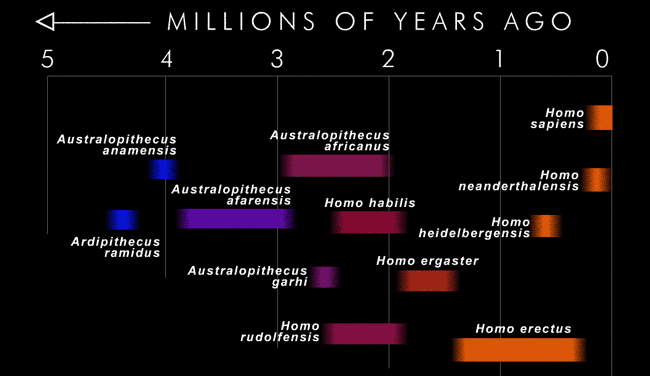
Tracing Fossil Finds : A Hominid Timeline

|
|
|
Homo sapiens
(archaic & modern)
|
|
|
Homo neanderthalensis
Europe, Western Asia: 200,000 to about 30,000 years ago. Stocky; adapted to the cold climate of their time. Our closest extinct relative; possibly a subset of our own species. |
|
|
Homo heidelbergensis
Europe: 800,000 to 250,000 years ago. Muscular and tall, with a sloping chin and forehead. May be a direct ancestor of Homo neanderthalensis .. |
|
|
Homo erectus
Africa, Asia, Europe: 1.4 million to 50,000 years ago. Similar to modern humans, but taller, stronger, and with a pronounced ridge over the brow. Thought to be the first to use rafts to travel the oceans. |
|
|
Homo ergaster
Africa: 1.9 to 1.4 million years ago. Considered an early, exclusively African form of Homo erectus . Started making stone tools 1.6 million years ago. |
|
|
Homo rudolfensis
|
|
|
Homo habilis
Africa: 2.3 to 2 million years ago. Known from only a few specimens; the first of the Homo genus known to use stone tools. |
|
|
Australopithecus
africanus
South Africa: 2.9 to 2 million years ago. Compared to the older A. afarensis , this species has a rounder skull and slightly larger brain. |
|
|
Australopithecus
garhi
Africa: 2.6 to 2.5 million years ago. The first tool-making hominids known. Probably not a direct ancestor in the human lineage. |
|
|
Australopithecus
afarensis
Africa: 4 to 2.8 million years ago. More than 300 specimens known. Bipedal with apelike features, including a prognathic (forward-protruding) face. |
|
|
Australopithecus anamensis
|
|
|
Ardipithecus
ramidus
Africa: 5.8 to 4.4 million years ago. The earliest proto-human known. Bipedal; about the size of a modern chimpanzee. |
|
![]()
http://www.exploratorium.edu/evidence
© Exploratorium | The museum of science, art and human perception